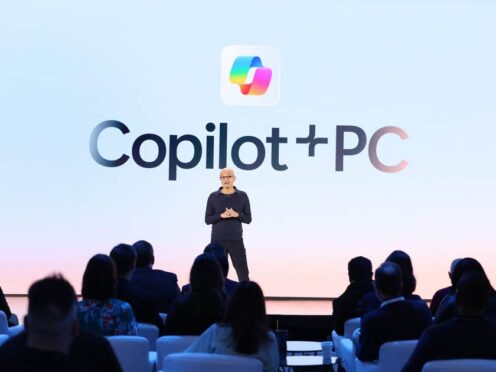Microsoft is the latest tech giant to make its pitch for being the leading AI company in 2024, unveiling new PCs built around its Copilot AI assistant.
Ahead of the firm’s developer conference, which begins on Tuesday, the company has announced its Copilot+ PC range, consisting of a Surface Laptop and Surface Pro tablet, which it says are the “fastest, most intelligent Windows PC ever built”.
They include a dedicated button to prompt the Copilot AI assistant at any time, as well new AI-powered apps such as Recall, which allows users to look back through their device to find what they’re looking for when they cannot remember its exact location using screenshots, phrases or any other cues they can remember.
Users will also be able to create AI-generated images quickly using Cocreator within the Paint app, which allow users to create images from text prompts or initial drawings, while Live Captions can translate audio from more than 40 languages into English in real time.
The all-new Surface Pro and Surface Laptop are the ultimate Copilot+ PCs, delivering incredible performance and brand-new AI experiences. #CopilotPCs
Learn more https://t.co/YaGNEm5zgh
— Microsoft Surface (@surface) May 20, 2024
As the largest investor in OpenAI, the makers of ChatGPT, Microsoft confirmed that the latest model to power the chatbot, GPT-4o, announced last week, would also come to Copilot+ PCs.
“This first wave of Copilot+ PCs is just the beginning,” Microsoft consumer chief marketing officer, Yusuf Mehdi, said.
“Over the past year, we have seen an incredible pace of innovation of AI in the cloud with Copilot allowing us to do things that we never dreamed possible.
“Now, we begin a new chapter with AI innovation on the device.
“We have completely reimagined the entirety of the PC, from silicon to the operating system, the application layer to the cloud, with AI at the center, marking the most significant change to the Window platform in decades.”
The company also confirmed that it was working with many of its third-party hardware partners, including Acer, Dell, Lenovo and Samsung, would launch Copilot+ PCs.
Microsoft’s announcement comes almost a week after Google laid out its plans to further embed AI in its products over the months to come, including rebuilding its search engine around AI-generated responses, and bringing its own generative AI assistant, Gemini, to more of its most popular apps.
Next month, fellow industry heavyweight Apple is expected to lay out its own AI plans when it holds its annual developer conference, WWDC, at its Cupertino headquarters.
Industry expert Geoff Blaber, chief executive of analyst firm CCS Insight said the range of announcements showed Microsoft’s “determination” to a key player in the AI space.
“Microsoft has identified an opportunity to re-energise the PC market, transform the user experience and has galvanised the PC ecosystem to support its vision,” he said.
“If the market needs evidence of Microsoft’s determination and drive under Satya Nadella or its commitment to lead in generative AI, Copilot+ is a further proof point.”
“Microsoft’s efforts to mobilise the ecosystem of manufacturers, silicon partners and developers is impressive and gives Copilot+ credibility at launch.
“However, success requires Microsoft to overcome several challenges not least, communication to consumers of what a Copilot+ PC is and what it enables that is unique and worth paying a premium for.”
